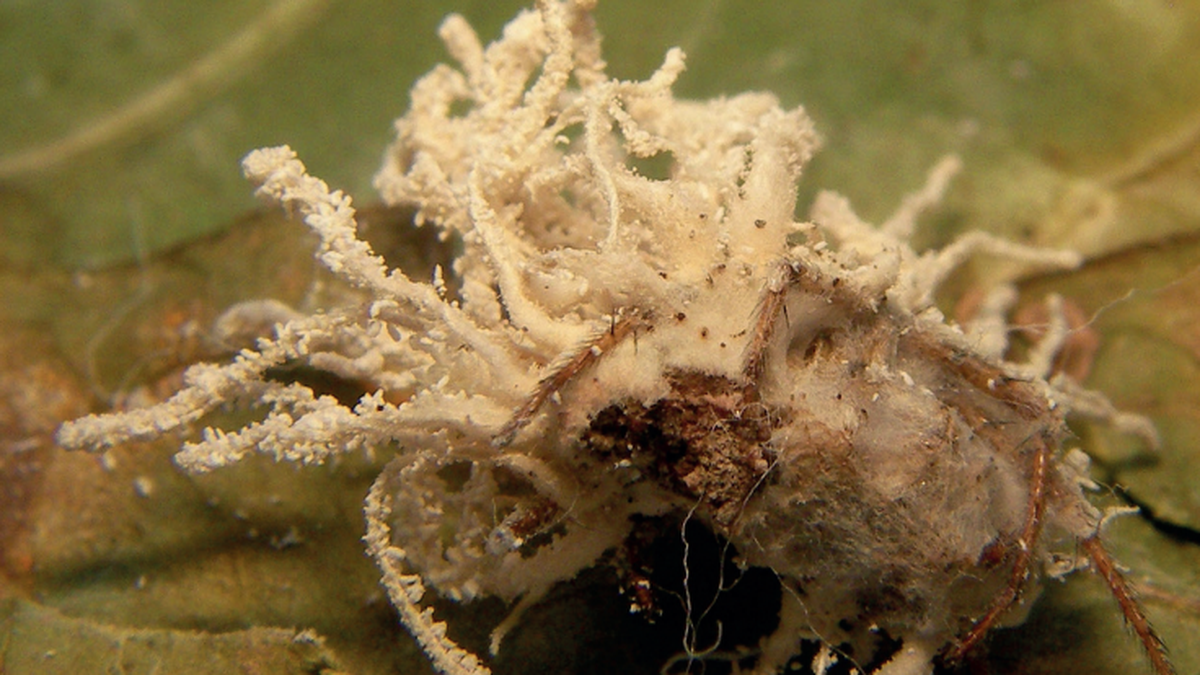Gibellula attenboroughii, spider host after removal and drying,
showing the multiple synnemata.
| Photo Credit: Fungal Systematics and Evolution
Researchers from the United Kingdom and Denmark recently discovered a new fungus that turns a particular species of spiders into brain-dead creatures — and named it for David Attenborough, the host of various natural history programmes on BBC. The homage is sincere: the researchers have said Mr. Attenborough’s work helped them discover the fungus.
The team’s findings were published in the journal Fungal Systematics and Evolution on January 24.
The new species, named Gibellula attenboroughii, affects cave-dwelling, orb-weaving spiders. According to the researchers, spiders that have been infected by the mycelium start behaving like zombie ants — which are regular carpenter ants that, when infected by a parasitic fungus, become erratic in their activities before dying. In the latter case, the fungus is Ophiocordyceps unilateralis, and it can control the host ants while possessing no brain or nervous system of its own. Scientists believe this is why the ants’ resulting behaviour is zombie-like.
Broadly, Gibellula is a genus of parasitic fungi that attack spiders.
In 2021, researchers first found a spider called Metellina merianae that had been infected by a fungus when filming BBC’s show ‘Winterwatch’ in Northern Ireland. They had spotted the spider on the ceiling of an abandoned store that sold gunpowder. They were reminded of the ants that died after being infected by O. unilateralis.
M. merianae was previously known to live in places made by humans, like cellars and culverts, and that it wouldn’t expose itself the way the spider did by walking around the ceiling. Researchers believe the arachnid’s exposed position was the fungus’s doing — to allow its parasitic spores to circulate more in the air currents.
“In all instances, the infected spiders had moved from their concealed lairs or webs and died exposed on the cave roof or wall and the store ceiling,” the team wrote in its paper.
The team collected the spider’s body, which was completely covered with a layer of fungus, and sent it for identification. This was 2022. The lab study also recorded fungal structures called synnemata all over the spider’s body, including the legs, with spore-producing conidiophores present along the length of the synnemata. The team found mycoparasites as well, which are fungi that attack other fungi and consume them for nutrition.
In the paper, the researchers also wrote that a subsequent investigation of Gibellula fungi in the British Isles led to the discovery of a diverse range of parasitic fungi and even more waiting to be found. This is important because the fungus’s presence can be correlated with disease outbreaks in the region, which are similar to those recorded in spiders in tropical regions. Gibellula’s “role in spider-population dynamics warrants further study, as do the metabolites they produce which enable them to exploit such a highly-specific ecological niche,” the researchers wrote.
From the Science pages
Question Corner
Flora and fauna
Published – February 12, 2025 05:11 pm IST
